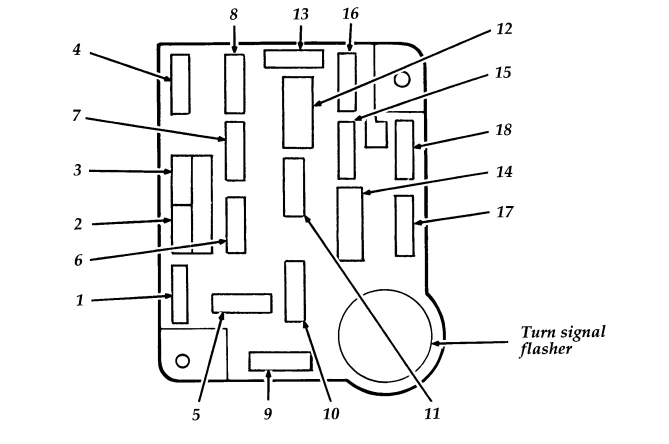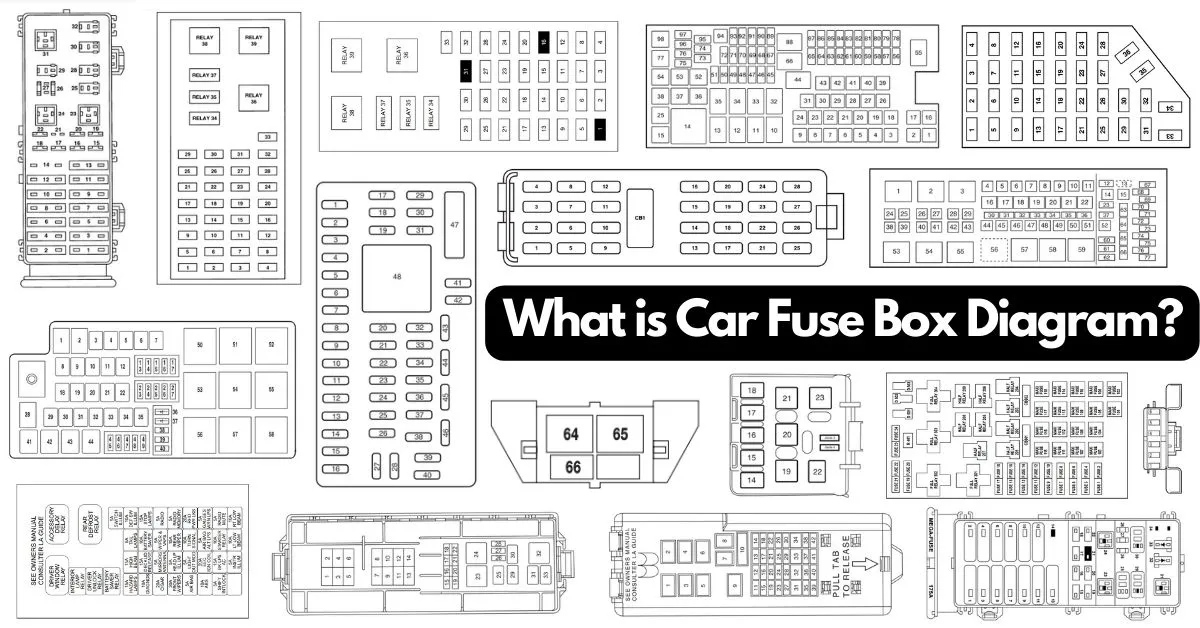The article will give a straightforward explanation of what a fuse box diagram is. Essentially, a fuse box diagram is a visual representation or drawing that displays how a fuse box is set up. It shows the arrangement of fuses, their ratings (how much current they can handle), and the circuits they correspond to within the fuse box.
The goal is to help readers fully understand what a car fuse box diagram is and what it consists of. Additionally, the article will highlight the advantages of using a fuse box diagram for maintenance and repairs, as well as promoting electrical safety.
Table of Contents
What is a Fuse Box Diagram?
A fuse box diagram is a visual representation or schematic that displays the layout and configuration of a fuse box. It illustrates the specific fuses, their ratings, and their corresponding circuits within the fuse box. It helps users understand the organization and function of the fuse box more easily.

- Fuse Types and Ratings: The different types of fuses used in a fuse box, such as blade fuses or cartridge fuses. It will also explain the importance of fuse ratings, which indicate the maximum current a fuse can handle without blowing. Fuse ratings are typically expressed in amperes (A) and are crucial for selecting the appropriate fuse for each circuit.
- Circuits: The circuit descriptions are provided in a fuse box diagram. Each circuit within the fuse box is labeled or described, indicating the electrical components or systems it powers. This information helps users identify the specific circuits related to different electrical functions or devices.
- Fuse Locations: A fuse box diagram includes information about the physical locations of individual fuses within the fuse box. It helps users quickly locate and replace specific fuses when needed, especially during troubleshooting or maintenance tasks.
What are the components of a car fuse box?
The fuse box acts as a central hub for controlling and protecting electrical circuits in a vehicle. The fuse box receives electrical power from a source (e.g. battery) and distributes it to different circuits within a vehicle. It ensures that each circuit receives the appropriate amount of current and provides protection against electrical faults or overloads. We will discuss the various components typically found in a fuse box below.
- Fuses: Fuses are safety devices designed to protect electrical circuits from overcurrent conditions. They consist of a thin wire or metal strip that melts when excessive current flows through it, thereby interrupting the circuit and preventing damage to the electrical system.
- Circuit Breakers: They are another type of protective device found in fuse boxes. Unlike fuses, circuit breakers can be reset after they trip due to overcurrent. They automatically detect abnormal electrical conditions and interrupt the circuit, providing protection against short circuits and overloads.
- Relays: These are electromagnetic switches that control the flow of current to various electrical components or circuits. They allow low-power signals to control high-power devices, ensuring proper functioning and protection of the electrical system.
Why Fuse Box Diagram is important?
The significance of having a fuse box diagram. By understanding the importance of a fuse box diagram, readers will realize its practicality and value in effectively managing and maintaining electrical systems.

- Troubleshooting Electrical Issues: A fuse box diagram is an invaluable tool for troubleshooting electrical problems. By referring to the diagram, users can identify the circuit associated with a malfunctioning electrical component and check the corresponding fuse. This helps pinpoint the root cause of the issue and enables efficient repairs.
- Preventing Electrical Accidents: It promotes electrical safety enabling users to understand the proper fuse ratings and ensuring that each circuit is adequately protected. By following the diagram, users can avoid overloading circuits, reduce the risk of electrical fires, and prevent damage to sensitive equipment.
- Maintenance and Repairs: It provides a clear overview of the fuse box layout, allowing users to easily identify and replace blown fuses. The diagram also aids in the proper installation of new fuses, ensuring the correct fuse type and rating are used for each circuit.
What are the benefits of using a Fuse Box Diagram?
Using a fuse box diagram has several practical benefits that make it a valuable tool. It can save you time by quickly identifying the right fuse and circuit, helping you address electrical issues more efficiently. With the aid of this visual reference, you can effectively manage your electrical system with confidence and resolve any problems that arise more easily.

1. Time-Saving: By referring to the diagram, users can quickly locate the specific fuse associated with a particular circuit or electrical component. This eliminates the need for time-consuming trial-and-error methods, allowing for efficient troubleshooting and repairs.
2. Cost-Effective: By accurately identifying and replacing blown fuses, users can avoid unnecessary expenses on replacing entire electrical components or systems. The diagram helps prevent potential damage caused by electrical faults, thus saving money on repairs and replacements.
3. Safety and Prevention: By understanding the correct fuse ratings and circuit configurations, users can ensure that each circuit is adequately protected against overcurrent conditions. This reduces the risk of electrical accidents, such as electrical fires or damage to sensitive equipment, promoting a safer environment for both individuals and property.
Explore more related to the car fuses which provides in-depth information on common causes of fuse failures and offers effective solutions. Enhance your understanding of car electrical systems and address fuse-related challenges with confidence. Please do check through the link below: Where is Car Fuse Box located? Can I replace a car fuse by myself? What are the most common car fuses? How many fuse boxes does a car have? What is the fastest way to check a car fuse? Do you need to disconnect battery to change fuse?
Conclusion
Throughout the article regarding the what is car fuse box diagram. A fuse box diagram serves as a valuable tool for understanding and managing electrical systems. The significance of following proper electrical practices, such as using the correct fuse ratings, understanding circuit configurations, and regularly inspecting the electrical system to maintain a safe environment. It helps in troubleshooting electrical issues, preventing accidents, and ensuring the safety of individuals and property.
Tom Smith is a passionate car mechanic and automotive enthusiast, specializing in the intricate world of car fuse boxes. With years of hands-on experience under the hood, he has earned a reputation as a reliable expert in his field. As the founder and content creator of the popular blog website 'carsfuse.com,' Tom has dedicated himself to sharing his extensive knowledge of car fuse boxes and electrical systems with the world.


